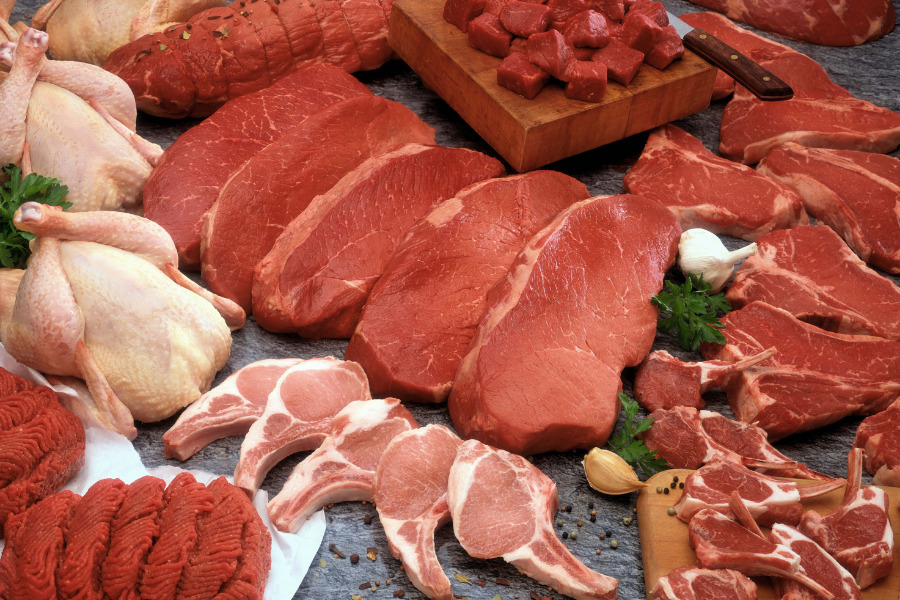The Food Industry Association and the Meat Institute Foundation reported that grocery store meat sales increased by 20% last year, with three-quarters of consumers saying meat belongs in a healthy diet.
“All protein sales at retail were up across the board, which isn’t surprising given the increase in at-home cooking in 2020,” Angie Krieger of the National Pork Board told The Food Institute in an email. “For mature categories like fresh pork and beef to see double digit volume growth [with chicken scratching closely behind at 9.1%], it demonstrates that while there are more competitors in the protein space, consumers continue to find comfort and appeal in the flavor and nutrition that real meat provides.”
Statistics released by IRI Worldwide in September and highlighted this week at the 2021 Annual Meat Conference in Kansas City, Missouri, indicated though meat sales underwent wild swings last year because of the COVID-19 pandemic, baseline sales remained above 2019 levels. The IRI Meat Department Report found that stores saw record sales in mid-March 2020 after quarantines went into effect and consumers began panic buying. They began re-spiking in July, and by August, meat sales set a new baseline 15% to 16% above 2019 levels.
“People returned to the familiar amid COVID-19 and meat returned to the center of plate,” IRI said, citing more at-home cooking as the driving factor.
Consumers apparently are going with what they know. A soon-to-be-released FoodThink study found consumers think meat and seafood are trustworthy. In fact, the percentage of consumers who think that way increased by five points in the past two years. Additionally, consumers said they planned to return to their pre-pandemic shopping behaviors in coming months, a spokeswoman told The Food Institute.
The IRI report indicated more than 98% of households bought meat in 2020 and 43% are buying more meat than they did before the pandemic.
“With COVID-19 deepening demand for convenient, affordable food that tastes good and matches Americans’ values, meat fits the bill,” Meat Institute President and CEO Julie Anna Potts said in a press release (March 23).
Rick Stein, vice president of fresh foods for FMI – The Food Industry Association, agreed: “Shoppers are cooking more at home due to the COVID-19 pandemic, and their confidence in cooking and preparing meat has increased. Further analysis also shows convenient meal solutions are key and that food retailers have opportunities to provide more choices and, along with more information and education on consumer priorities like nutrition and meal preparation – building up what we call consumers’ Meat IQ.”
IRI noted meat department sales reached $82.5 billion in 2020, an increase of 19.2%, with volume up 11%.
“The sales increases were driven by more meat trips and a higher spend per trip, while maintaining very high household penetration, at 98.4%. Gen Z, millennials and Gen X all had above average contributions to growth,” IRI reported. Online orders also saw meat sales increase – 31% versus 19% in 2019.
Anne-Marie Roerink, principal at 210 Analytics, which prepared the Power of Meat report presented at this week’s Kansas City conference, said the pandemic forced a change in consumer shopping habits, reducing the number of trips to the grocery story but increasing basket size – and the trend continued through February. Beef had an especially strong year, a result Roerink labeled “incredible,” Meat + Poultry (April 13) reported.
“2020 was a record year for all animal proteins, but especially pork,” the National Pork Board’s Krieger said. “Fresh pork volume outpaced the rest of the fresh category, with total pounds up 18.1% from 2019, and the $7.2 billion sold in 2020 represented an increase in the consumer spend of 10.8% from a year ago.”
The international trend, however, tells a slightly different story compared with last year’s record levels. Statistics from the U.S. Meat Export Federation indicate pork exports were down 12% in February compared with last year, and are off 11% for the first two months of the year by weight. Beef exports were off 8% for February but were virtually unchanged for the first two months of the year.











